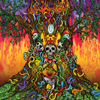Master Musicians of Bukkake, "Totem 3"
 This is the final chapter of this colorfully named and eternally shifting Seattle collective's Totem trilogy and it is confounding and inspired in equal doses.  Characteristically, the band still sounds like some kind of weird psychedelic cult, but the fictitious cult in question seems to shift in both disposition and temporal/geographic location a bit more dramatically than they have in the past, which makes for a rather strange and disorienting listening experience.  At least it is confusing for the right reasons though, as Totem 3's problems stem primarily from sheer over-ambition: there is literally no one on earth that could successfully and seamlessly combine influences as disparate as metaphysical philosophy, John Carpenter, Indian cinema, and Taureg blues.
This is the final chapter of this colorfully named and eternally shifting Seattle collective's Totem trilogy and it is confounding and inspired in equal doses.  Characteristically, the band still sounds like some kind of weird psychedelic cult, but the fictitious cult in question seems to shift in both disposition and temporal/geographic location a bit more dramatically than they have in the past, which makes for a rather strange and disorienting listening experience.  At least it is confusing for the right reasons though, as Totem 3's problems stem primarily from sheer over-ambition: there is literally no one on earth that could successfully and seamlessly combine influences as disparate as metaphysical philosophy, John Carpenter, Indian cinema, and Taureg blues.
Totem 3 begins with a piece entitled "Bardo Sidpa," which is a Tibetan Buddhist term that roughly translates into a rebirth into the world after reaching a transcendental state.  Such a return is apparently quite difficult and fraught with spiritual traps, so the piece is quite an ominous one, built around Randall Dunn's Tibetan throat singing and mournful brass.  One of the instruments used is actually a long trumpet called a Rag dun, which is traditionally used by Tibetan monks, further confirming that these guys are extremely serious about thematic consistency (for now).  The horn drones are further augmented by jangling chimes, slowly pulsing and discordant faux-accordion chords, and suicidally plunging synth tones.  It's a pretty sinister piece of ritualistic ambiance and a rather strong one too, but it then segues into the much lighter "In the Twilight of Kali Yuga."  After a briefly droning flute introduction, it transitions into a stomping and joyous acoustic guitar and tabla piece that sounds like some kind of fake Indian wedding dance.  This is where things begin to derail a bit, as it is simply too relentlessly cheery for me, despite its appealing enthusiasm and heft.
The third piece, "Illuminating the Ten Directions," brings things back down to drone territory, but still fails to win me back, as the "desert nomad" flute noodling and chanted vocals sit somewhat clumsily with the low-end synth hum and occasional distorted electric guitar strums.  The collision of "organic and spiritual" with "contemporary and electrified" just isn’t seamless or logical enough to be convincing. The following "Prophecy of the White Camel/Namoutarre" gets back a little momentum though, approximating a darker, slower negative of "Kali Yuga" mixed with a bit of Sun City Girls-style psych (no coincidence, since Alan Bishop contributes guest vocals to both pieces).  There's a lot to like about it, as the percussion is pretty crushing and locks into a hypnotic, slow-motion groove and Timba Harris (viola/violin) and Milky (electric guitar) both keep things interesting and vibrant melodically.  Also, there is some boisterous ululating at the end, which I always enjoy.
The album draws to a finish with three very jarring curve balls in a row.  "6000 Years of Darkness" sounds like some sort of bizarre cross between a Leone/Morricone Western and medieval chamber music with nothing quasi-ethnic, heavy, or psychedelic included to link it thematically with anything around it.  Then "Reign of Quantity and the Signs of the Times" takes things about as far as they can go in the opposite direction, sounding like a space station computer going haywire right before it self-destructs. Then that is followed by the brief and weirdly anticlimactic John Carpenter soundtrack-worship of "Failed Future."  I dig Escape From New York and Assault on Precinct 13 as much as the next guy, but I don't understand why anyone would want to reproduce such a time- and context-specific sound on an India/Tibet-themed psych concept album in 2011.
I dearly wish I liked this album more than I do, as Totem 2 was amazing and it is disappointing to see the trilogy end on a lesser note. Most frustrating is that the individual songs (for the most part) are fairly imaginative and well-executed, but they don't make much sense in the context of the entire album.  The Master Musicians of Bukkake on Totem 3 simply do not at all sound like the same band from song to song, even though there was obviously a lot of thought involved in the album's construction and sequence (ie- the titles provide clues to a coherent thematic arc, the structure mirrors previous Totems, and the "Om ah ra pa ca na dhih" chant is repeated in three songs).  This album does not flow.  These guys are a consistently excellent band, but they are also a fairly chameleonic one, so the fact that Totem 3’s mission did not entirely succeed is not cause for much concern Chalk this one up as a flawed experiment.
samples:
 




